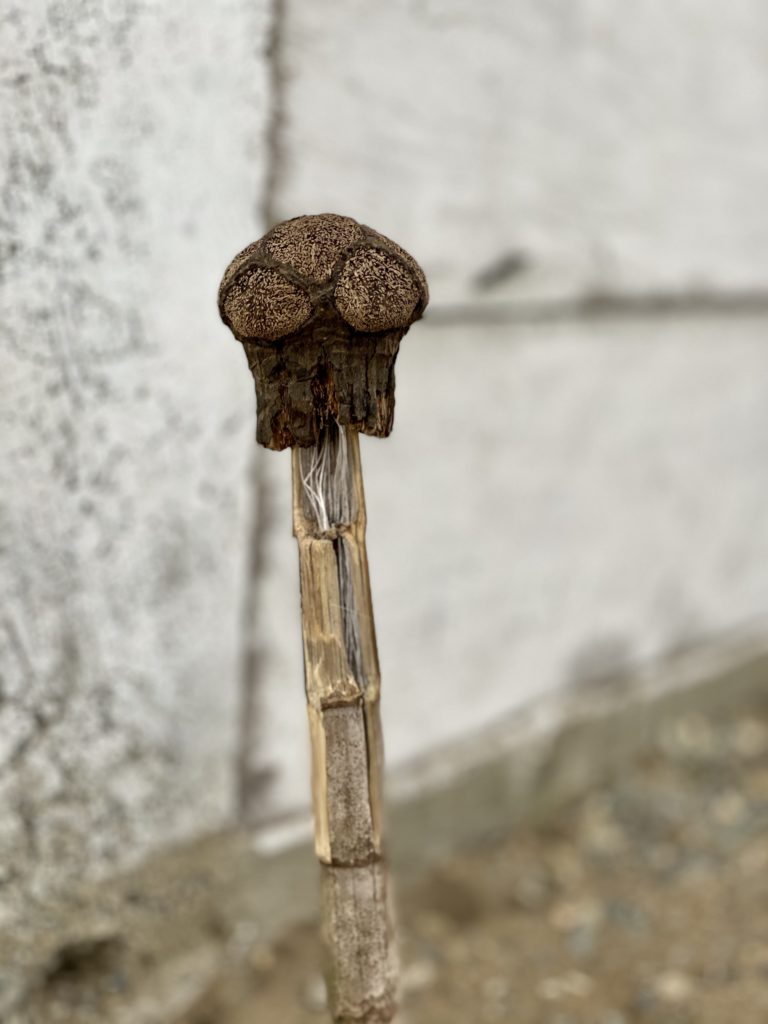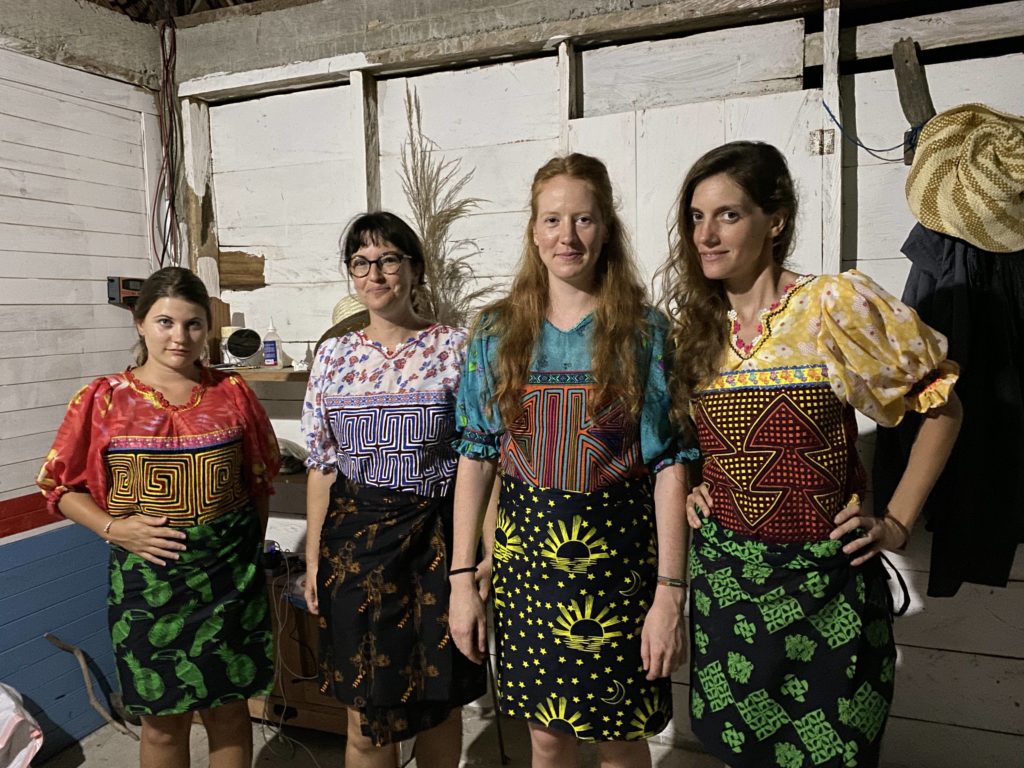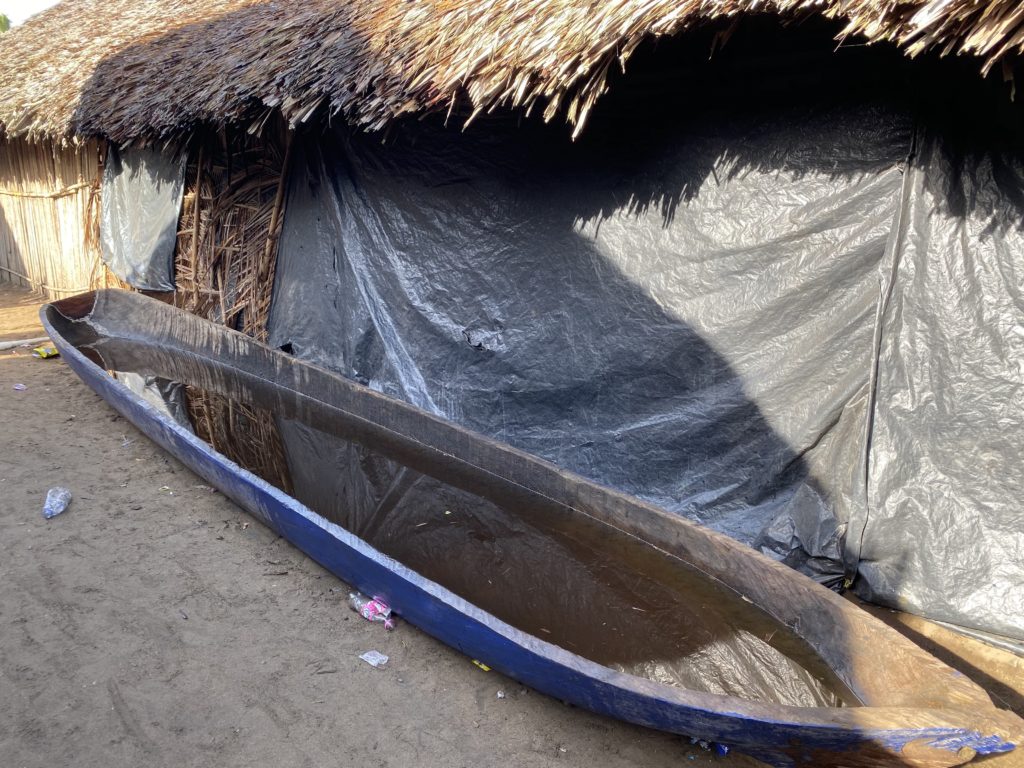The town is up at 5am. It seems that everyone has congregated outside my room. I’m exhausted from the mosquito bites that kept me up last night and can’t haul myself out of bed to see what’s going on. I’ll go for a walk around the town at 7am. The neighbours are hosting some out-of-towners and they were talking, laughing and watching TV until pretty late last night. Their stamina is amazing.
On the way to breakfast I decide to walk around for a bit and near the chicha house, I see at least thirty men hard at work building a temporary house. While it has the frame of a traditional house, the walls are made of thatch and they don’t go all the way up to the roof beams. It will be used at some point during these three days, though it’s unclear what it’ll be for. Nobody really has a ‘schedule’ for daytime activities, although we do know that the ceremony proper starts at 8pm tonight and will continue throughout the night.
There are a disproportionately high percentage of albinos in the village. We aren’t sure if it is a birth defect that’s hereditary or that the Guna are more predisposed to this genetic mutation. But they have their own way of dealing with them. Albinos, rather than being shunned, are seen as visionaries because their natural sight is impaired or extremely sensitive to sunlight. So they are said to be able to ‘see’ in other ways, as shaman-like figures.
Luz used to call a toe a foot finger for years. It’s both cute and quaint and immediately gives the toe a bit more credibility.
Caroline and I trade fan boy stories of David Sedaris. Apparently, all he does now is walking around his village in the UK and pick up trash.
Google doesn’t work in Iceland; the algorithm doesn’t work for such a small number of people. You either have to search for something specific that you know or you ask in another language and then translate. Perhaps life would be better if less of it could be found so easily.
During the Chicha ceremony, there are flowers on the nivar stem placed around the houses as a ward against bad spirits. Plants are sisters that protect us from other layers and worlds.
Those who can see beyond the natural world travel through various layers that the Guna belief existence is composed of. And in their travels they make a space for lost spirits, people who have died unnaturally and have not passed to the next world. These traveling visionaries are able to build a house for these spirits in a kind of middle space.
People who die naturally, on the other hand, have to be placed under the soil to be reborn and the Guna make a soil belly, a mound for Mother Earth above. This is such a difference from the Torajan people in South Sulawesi, Indonesia, who believe in the sacredness of the ground and so bury their dead above the ground, carving niches in rocks and dangling coffins from cliffs.
The Guna also have particular practices when it comes to animals. If a snake bites someone and the snake hasn’t been killed, no one can leave the community for four days and everyone has to drink a special serum prepared by the botanist.
Later on in the morning, I sneak a peek into the chicha house. The men are moving back and forth in a line. It looks like a rugby scrum, but half the men are carrying tortumas, and the other half drink out of them. Then they swap. This could be practice for later, although they do seem to be drinking the real thing.
In the evening, I make a small totem from a stick and a seed that looks like an alien face. Inspired by the niva, it will be our ward during the chicha.

I Dream of Medusa
Material: seed, bamboo stick
When the jellyfish come
they will be in bobbing clouds
of soundless bodies, wild
tentacles grasping the sky.
A touch is electric enough
to entrance and turn us:
not to stone, but husk;
empty of desire,
floating in their wake.
We keep them dried,
carefully planted at corners
of houses; may whatever
darkness that tries to enter
look them in the eyes.
I try to sketch a dice that I found on the beach. It seems easy but I really struggled to get the angles right. It’s a lot harder with small objects.
A boat arrives from Anachucuna. It’s about the size of the boat we were on yesterday. Packed onto it are 30 people, all men. It sits really low in the water and takes an eternity to navigate into the mouth of the river. A sizeable crowd is waiting onshore to welcome them.
When Nacho was in La Miel with Veronica this morning shopping for supplies, he met four tourists who had come from Capurgana. They are a mix of young French and Germans. Being Nacho, he offered them his cabins at the end of the village and invited them to experience the chicha. They also had meals at our house. Instinctively, I feel slighted that they could just rock up and attend such a significant ceremony, but when I thought about it, the importance would be lost on them and they would see it as a ‘wild’ native ritual, whereas we have had a couple of weeks to prepare and learn about it.

We enter the chicha house after dinner, at 7pm. The actors, who are those who serve the chicha, smoke enough tobacco for a year of cigarettes. They light their wooden pipes from dried tobacco leaves. Smoke fills the house, thick and sweet. They wear necklaces made from pelican bones, long and thin. It jangles to no particular rhythm. Everyone gets his or her face and feet painted with the paste from the plant that is used as protection from sunburns. When that is done, the chicha begins with a pretty tasty corn chicha. It’s non-alcoholic. Then some men form a line and fill an entire canoe with the real chicha. That takes a while.

When it’s ready, servers carry tortumas, which have a handle of bone tied across the mouth, making it easy to hold and to dip into the canoe for refills.
When you’re asked to drink you have to drink, all of it, and not too slowly at that because there’s another round of guys waiting behind. Each set of men is 8 servers and 8 recipients. Because in Guna mythology, the sun has eight brothers. Each tortuma holds the equivalent of two to three glasses of wine. It doesn’t hit at first; but after four rounds I start to feel really uncomfortable. A fifth round would probably make me puke, so I duck out for a toilet break and to make notes.
The men and women are separated; and the women were yet to drink when I left, although a small group of older Guna ladies hung by the canoe, where the canoe servers gave them tortumas, which they shared among themselves. Nowhere near the binge drinking of the men, which is something serious. Luis’ trick is to spill half of the liquid down the front of his shirt, which is the same colour of the chicha. That’s how he survives. I might have to start doing the same!
Apparently, dancing and singing myths will start at 2a.m. I will try to get up then.
Around 11pm, I wake up. The girls are back for a bathroom break and I’m pretty high. The alcohol has fully soaked in. I mention something about being a frog and saying that Luz is a rainbow. But I don’t feel absolutely terrible so I follow them back, deciding to stay outside and not to drink. Luis is still there, incredibly, but he’s pretty wasted. Nacho has somehow made it through and he’s on his feet as well. As I’m sat outside, though, a bowl almost immediately comes to me, I take a sip, gag and hand it to the German tourist next to me. I race (or lurch, rather) to the toilet and am violently sick. But better out than in. When I rejoin the group they are making exit plans to hang out in the beach behind Luiz’s house, a Guna local who looks like a muscular Bali boy, long hair, quick smile and all.
We grab chairs and beers from his house and sit under a partly cloudy sky. The stars are dazzling and somewhere over the ocean, there is a lightning storm going on.
At some point we get up to help Luis into the house. He kind of fell asleep on the beach for a while. At a later point I decide to walk to the ocean to pee. Beyond the lights, there is a sharp line of darkness, I head for it, and promptly fall down a small slope of sand. This part of the beach is quite steep. I stay on my feet, water lapping around me, and try to climb back up. I cannot. And in my silly state of mind, I had decided that this was the only way up. I must have looked like a large, dysfunctional crab trying to crawl out of a too deep hole. Fortunately, a light comes bobbing my way from the other end of the beach. It’s a local Guna man, and I can’t tell him anything than ‘Si, claro’ because I presume he’s asking if I’m ok. But by his light I can see that the beach becomes a gentle incline a short distance away, and that allows me to get back up. Also, why are there so many canoes on the beach! Someone could totally trip over or into them.
Tilting her head back, the stars make Veronica feel like she is melting. She pukes.
We head back to the chicha house around 3 to see if they have started the next stage of the ritual. Two pairs of men stand on either side of the central portion of the house, holding a rope in their hands. In the middle, more men are working on putting together a large hammock. Everyone stops frequently to drink. Designated tobacco smoke blowers dance around, blowing directly into the mens’ faces. At some invisible cue, the pairs of men crisscross each other, taking turns to duck under the rope. They are moving fast, using the rope to break their sprints. This is how the main rope that holds the hammock gets woven. The hammock will be for the cantule, (the main singing sahilar), who will recite the names of the girl. Yes, this whole ceremony is about one girl. Although it is also a chance for the Guna to celebrate an important part of their heritage, something we haven’t really seen in the village. Daily life, while simple, still revolves around the trappings of modern life; televisions, mobile phones. The ceremony is primal, intense and raw. This is no packaged cultural show put on three times a day for busloads of tourists.
A little later on, a few men and a couple of women gather in a line and do a kind of dance/shake with maracas. They seem to gravitate toward the different pillars that support the building. They shake and roll and then stop (to drink chicha) but also for the lead dancer to blow a low, sonorous note into a pipe. It seems aimed right at the pillar. No one is around who can explain the meaning behind this.
Music has been everywhere in the time I’ve been here. There’s always a Latin bass line going on somewhere and traditional music fights for space with auto-tuned pop. The chicha house reverberates with the sound of men urging each other to drink, women chatting on the periphery, and the maracas of the dancers, an ebb and flow of dancing tension.
Maria offers a great thought, ‘We are made of rhythms.’ And it’s so true. Our heartbeat is our first drum. We depend on rhythm to stay alive.
I leave at 5.30am to sleep, exhausted by the constant tobacco smoke, having to dodge tortumas and the long night. Outside, a storm is passing over the town and it is just beginning to rain. The sky is lightening and soon it will be the second day of the chicha. There are at least 100 people still in the chicha house when I stumble home.
